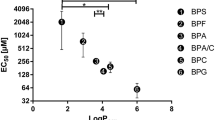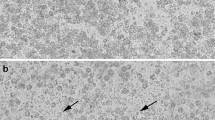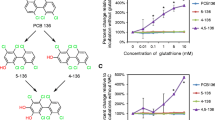Abstract
The relation between the metabolism and the cytotoxic effects of bisphenol A (BPA, 2,2-bis(4-hydroxyphenyl)propane) has been studied in freshly isolated rat hepatocytes and isolated hepatic mitochondria. The incubation of hepatocytes with BPA (0.25–1.0 mM) elicited a concentration- and time-dependent cell death, accompanied by losses of intracellular ATP and total adenine nucleotide pools. BPA at a low-toxic level (0.25 mM) in the hepatocyte suspensions was rapidly converted to its major conjugate, BPA-glucuronide, and other minor products without marked loss of cell viability, although at a toxic level (0.5 mM), more than 65% of the compound presented in an unaltered form 2 h after the incubation. Addition of salicylamide (2 mM), non-toxic to hepatocytes during the incubation period, enhanced BPA-induced cytotoxicity and reduced the loss of BPA and the formation of BPA-glucuronide. The addition of BPA to isolated hepatic mitochondria caused a concentration (0–0.5 mM)-dependent increase in the rate of state 4 oxygen consumption in the presence of an FAD-linked substrate (succinate), indicating an uncoupling effect, whereas the rate of state 3 oxygen consumption was inhibited by BPA. Further, the addition of BPA (0.25 mM) reduced state 3 respiration with NAD+-linked substrates (pyruvate plus malate) and/or with the FAD-linked substrate, whereas state 3 respiration with ascorbate plus tetramethyl-p-phenylenediamine (cytochrome oxidase-linked respiration) was not significantly affected by BPA. A comparative study of the toxic effects of BPA and some bisphenols on cell viability (at 1.0 mM) and mitochondrial respiration (at 0.25 mM) revealed that 4,4′-(1,2-diethyl-1,2-ethenediyl)bisphenol (diethylstilbestrol) was more toxic than BPA, followed by 4,4′-methylenediphenol and 4,4′-biphenol. These results indicate that the onset of cytotoxicity caused by BPA may depend on the intracellular energy status and that mitochondria are important targets of the compound. The toxicity caused by the inhibition of ATP synthesis may be related to the concentration of unmetabolised free BPA remaining in the cell suspensions. In addition, the toxic potency of bisphenols to hepatocytes and mitochondria depends on the relative elongation and/or molecular size of the hydrocarbon bridge between the phenolic groups.
Similar content being viewed by others

Author information
Authors and Affiliations
Additional information
Received: 25 October 1999 / Accepted: 31 January 2000
Rights and permissions
About this article
Cite this article
Nakagawa, Y., Tayama, S. Metabolism and cytotoxicity of bisphenol A and other bisphenols in isolated rat hepatocytes. Arch Toxicol 74, 99–105 (2000). https://doi.org/10.1007/s002040050659
Issue Date:
DOI: https://doi.org/10.1007/s002040050659



